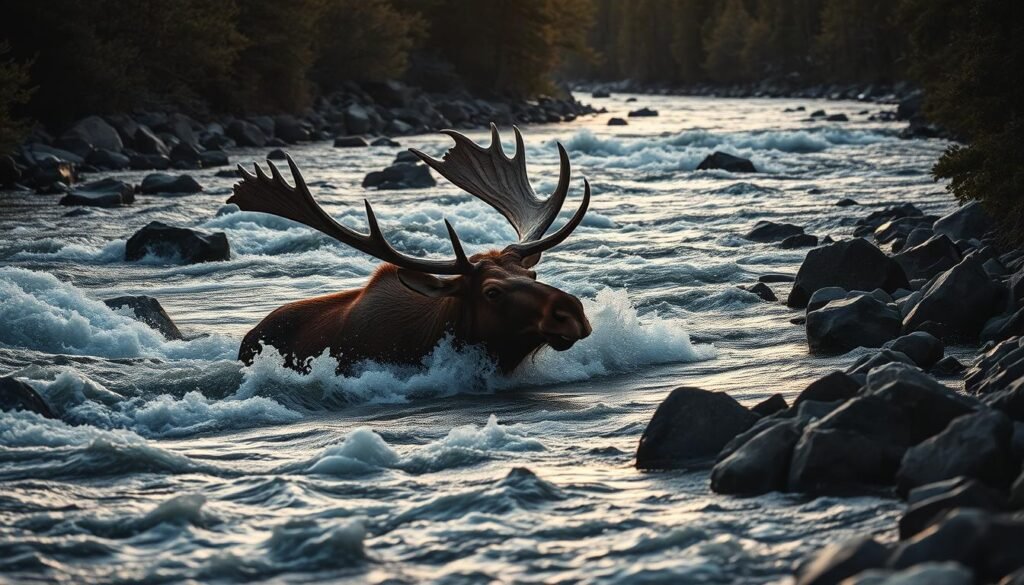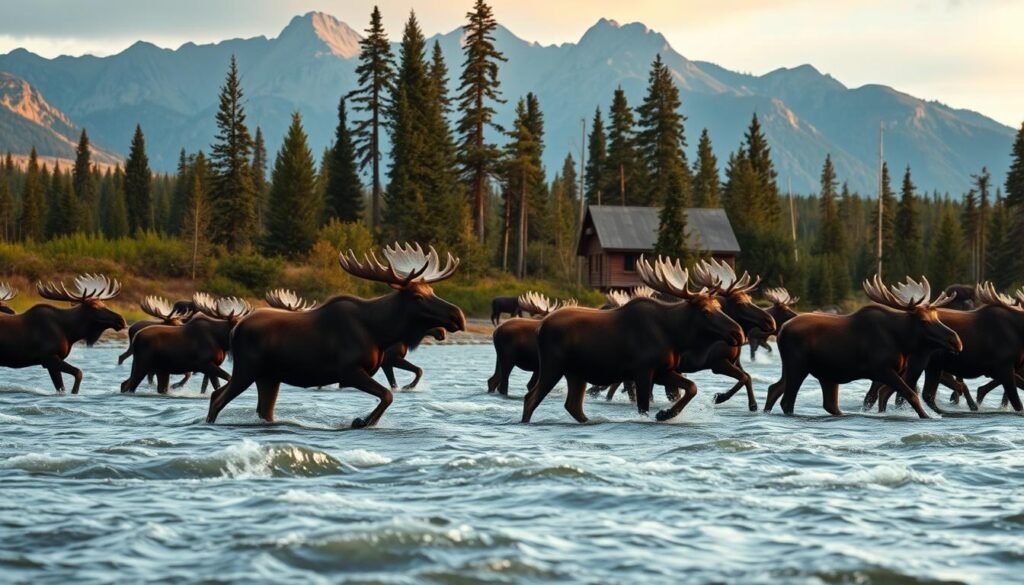Why Moose Swim Across Rivers During Migration? Exploring the world of wildlife is fascinating. You might be curious about the moose migration. These amazing creatures travel long distances, including river crossings. Their strong swimming abilities help them cross rivers easily.
But why do moose go on such long journeys? Their river crossings are driven by many factors. These include finding food, looking for a safe place to live, and avoiding predators.
Learning about moose migration helps us understand their behavior and needs. It also shows us the challenges they face. As we explore this topic, you’ll learn to appreciate these incredible animals and their habitats even more.
Contents
- 1 Moose Biology and Migration Fundamentals
- 2 Why Do Moose Swim Across Rivers During Migration?
- 3 The Impressive Swimming Abilities of Moose
- 4 Challenges and Dangers Moose Face During River Crossings
- 5 Observing and Protecting Moose Migration Routes
- 6 Understanding Moose Migration and Conservation
- 7 FAQ: Why Moose Swim Across Rivers During Migration?
- 7.1 Why do moose migrate?
- 7.2 Are moose good swimmers?
- 7.3 What dangers do moose face when swimming across rivers?
- 7.4 How can we help protect moose migration routes?
- 7.5 What is the role of wildlife corridors in moose migration?
- 7.6 How do human activities affect moose migration?
- 7.7 Can moose swim long distances?
Moose Biology and Migration Fundamentals
To understand why moose migrate, we must look at their biological needs. Moose are big, hoofed animals living in northern areas like forests and tundras. Their homes are cold and full of plants, which they need to survive.
Moose eat plants like leaves, twigs, and water plants. Their need for food drives their migration. For example, in winter, they go to places with less snow to find food. [Why Moose Swim Across Rivers During Migration?]
The seasons change, and so does where moose can find food and live. In spring, as snow melts and plants grow, moose move to areas with plenty of food. Knowing these migration fundamentals helps us understand moose behavior.
Studying moose biology and migration habits teaches us about their relationship with nature. This knowledge is important for protecting them and understanding their role in the ecosystem.
Why Do Moose Swim Across Rivers During Migration?
Moose often swim across rivers during migration. This shows their ability to adapt and survive. You might ask why they go through such tough river crossings. The reasons are complex, involving several factors that push them to migrate.
One key reason for moose river crossings is to find food. Moose move to places with lots of plants to eat. Rivers separate different habitats. By swimming, moose reach new areas with plenty of food, which is vital for them, especially in winter.
Another big reason is predation avoidance. Moose may swim to get away from predators or to find safer places to give birth. Swimming helps them avoid danger by crossing areas hard for predators to follow.
Migration challenges like crossing rivers are part of a moose’s life. These challenges test their strength and shape their migration paths. Moose’s ability to swim shows their amazing adaptability to various environments.
Rivers also play a role in connecting habitats. For moose, swimming across rivers helps keep their populations diverse. It connects different habitats, which is key for their survival.
In summary, moose swim across rivers for many reasons. These include finding food, avoiding predators, and keeping habitats connected. Knowing these reasons for moose river crossings helps us understand their migration better.
The Impressive Swimming Abilities of Moose
You might be surprised to learn that moose are excellent swimmers. They can cross vast bodies of water. Their swimming skills are key during their migration. [Why Moose Swim Across Rivers During Migration?]
Moose have special features that help them swim well. Their long legs and strong strides push them through the water. Their coats also repel water, reducing drag and letting them swim longer.
When comparing moose to elk, both are great swimmers. But moose are more at home in the water. Here are some key differences:
- Moose have longer legs, which help them swim more efficiently.
- Elk are generally more agile on land, but moose have an advantage in the water.
- Moose can dive to greater depths than elk, making them more adaptable to different aquatic environments.
Moose vs. Deer Swimming Abilities
Moose also outperform deer in swimming. Some notable comparisons include:
- Moose are stronger swimmers and can cover longer distances.
- Deer tend to avoid deep water, whereas moose are comfortable in it.
- The physical adaptations of moose, such as their coat and body structure, make them better suited for swimming.
Overall, the swimming abilities of moose show their remarkable adaptability and resilience during migration. [Why Moose Swim Across Rivers During Migration?]
Challenges and Dangers Moose Face During River Crossings
Moose face many dangers when they swim across rivers. These dangers come from both nature and humans. [Why Moose Swim Across Rivers During Migration?]
Swift Currents and Deep Waters
One big danger is the strong currents and deep waters of rivers. Strong currents can pull moose away from their goal. Deep waters are also risky because moose may get tired or struggle to find the bottom.

While rare, moose can be attacked by large fish and other wildlife while swimming. Young or weak moose are more likely to be attacked during these times.
Dams and Water Management Systems
Dams and water management systems can change rivers, making crossings harder for moose. These changes can affect water flow and depth, making it more dangerous for moose.
Boat Traffic and Recreational Activities
Boat traffic and recreational activities can also harm moose. They can cause moose stress and lead to accidents. Humans and machines can disrupt moose migration patterns, putting them in danger.
It’s important to understand these dangers to protect moose. By knowing what they face, we can help keep moose safe and healthy. [Why Moose Swim Across Rivers During Migration?]
Observing and Protecting Moose Migration Routes
Watching and protecting moose migration paths is key to keeping moose populations healthy. As you learn more about these amazing animals, you’ll see why it’s vital to protect moose and their homes.
Conservation is essential for moose health. We create wildlife corridors to let moose migrate safely. This means managing human activities near their paths to protect their habitats.
You can help by sharing the need to protect moose migration paths. Simple steps, like respecting wildlife areas, can help a lot. Also, supporting groups focused on conservation can aid in protecting moose.
Knowing about moose migration routes and their challenges is crucial. Together, we can help these incredible animals thrive in their natural homes.
Understanding Moose Migration and Conservation
Moose migration is complex and fascinating. They swim across rivers to find food, habitats, and breeding grounds. Their swimming skills help them overcome tough water challenges.
Our discussion shows how vital it is to know about moose biology and migration. Recognizing the dangers they face in river crossings highlights the need for conservation. [Why Moose Swim Across Rivers During Migration?]
It’s key to protect moose migration routes and habitats for their survival. Public awareness is crucial for conservation. By supporting conservation efforts, you help preserve moose migration and their ecosystems.
See Also: Discover Why Chameleons Change Color to Communicate
FAQ: Why Moose Swim Across Rivers During Migration?
Why do moose migrate?
Moose migrate to find food and escape harsh weather. They also go to their breeding grounds. Their paths change with the seasons, food, and habitat quality.
Are moose good swimmers?
Yes, moose are great swimmers. They have strong legs and bodies that help them swim well. [Why Moose Swim Across Rivers During Migration?]
What dangers do moose face when swimming across rivers?
Moose face dangers like fast currents and deep waters when swimming. They also worry about predators and human-made structures. Boats and recreational activities can disturb them too.
How can we help protect moose migration routes?
You can help by supporting conservation and respecting wildlife corridors. Be careful near their habitats and support groups that protect their paths.
What is the role of wildlife corridors in moose migration?
Wildlife corridors are key for moose migration. They offer a safe path for moose to travel. These corridors help reduce human impact on their habitats.
How do human activities affect moose migration?
Human activities like deforestation and urbanization harm moose migration. They fragment habitats and disrupt paths. It’s important to manage these activities to protect moose migration.
Can moose swim long distances?
Yes, moose can swim long distances. They swim for miles to find food, shelter, or to reach breeding grounds. [Why Moose Swim Across Rivers During Migration?]

Zyair Larson, based in Denver, Colorado, has over 12 years of experience studying animal behavior. He has worked with the World Wildlife Fund (WWF) and National Geographic, researching wildlife and sharing insights on animal habits globally.

